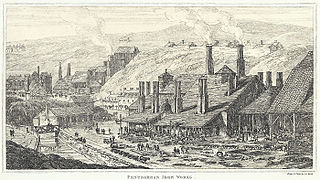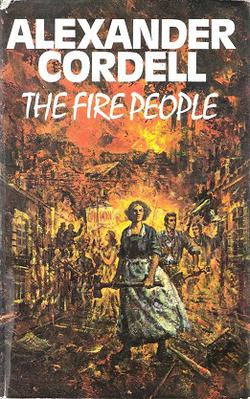
Until 1974, Glamorgan, or sometimes Glamorganshire, was an administrative county in the south of Wales, and later classed as one of the thirteen historic counties of Wales. Originally an early medieval petty kingdom of varying boundaries known in Welsh as Morgannwg, which was then invaded and taken over by the Normans as the Lordship of Glamorgan. The area that became known as Glamorgan was both a rural, pastoral area, and a conflict point between the Norman lords and the Welsh princes. It was defined by a large concentration of castles.

Until 1974, Brecknockshire, also formerly known as the County of Brecknock, Breconshire, or the County of Brecon, was an administrative county in the south of Wales, later classed as one of the thirteen historic counties of Wales. Named after its county town of Brecon, the county was mountainous and primarily rural.

Merthyr Tydfil is the main town in Merthyr Tydfil County Borough, Wales, administered by Merthyr Tydfil County Borough Council. It is about 23 miles (37 km) north of Cardiff. Often called just Merthyr, it is said to be named after Tydfil, daughter of King Brychan of Brycheiniog, who according to legend was slain at Merthyr by pagans about 480 CE. Merthyr generally means "martyr" in modern Welsh, but here closer to the Latin martyrium: a place of worship built over a martyr's relics. Similar place names in south Wales are Merthyr Cynog, Merthyr Dyfan and Merthyr Mawr.

Mid Glamorgan is a preserved county of Wales. From 1974 until 1996 it was also an administrative county with a county council.

Alexander Cordell was the pen name of George Alexander Graber. He was a prolific Welsh novelist and author of 30 acclaimed works which include, Rape of the Fair Country, Hosts of Rebecca and Song of the Earth.

Harri Webb was a Welsh poet, Welsh nationalist, journalist and librarian.

Merthyr Town Football Club is a Welsh semi-professional football club based in Merthyr Tydfil, currently playing in the Southern League Premier Division South, in the seventh tier of the English football league system.
Richard Lewis, known as Dic Penderyn, was a Welsh labourer and coal miner who lived in Merthyr Tydfil and was involved with the Merthyr Rising of 3 June 1831. In the course of the riot he was arrested alongside Lewis Lewis, one of the primary figures in the uprising, and charged with stabbing a soldier with a bayonet. The people of Merthyr Tydfil doubted his guilt, and signed a petition for his release. However, he was found guilty and hanged on 13 August 1831. After his death he was treated as a martyr in Merthyr and across Wales.

Penydarren Ironworks was the fourth of the great ironworks established at Merthyr Tydfil in South Wales.

Penydarren Park is a sports stadium in Merthyr Tydfil, Wales, that is the present home ground of Merthyr Town Historically used for varying sports, it has been the home to two professional football teams, Merthyr Town and Merthyr Tydfil F.C.
This article is about the particular significance of the year 1831 to Wales and its people.
Shoni Sguborfawr or Sioni Ysgubor Fawr (1811–1858) was a Welsh criminal, most notable for his part in the Rebecca Riots and his subsequent attempts to blackmail fellow rioters.
Penydarren is a community and electoral ward in Merthyr Tydfil County Borough in Wales.

Penderyn is a rural village in the Cynon Valley, Rhondda Cynon Taf, Wales, located near Hirwaun.

Merthyr Tydfil County Borough is a county borough in the south-east of Wales. In mid 2018, it had an estimated population of 60,183 making it the smallest local authority in Wales by both population and land area. It is located in the historic county of Glamorgan and takes its name from the town with the same name. The county borough consists of the northern part of the Taff Valley and the smaller neighbouring Taff Bargoed Valley. It borders the counties of Rhondda Cynon Taf to the west, Caerphilly County Borough to the east, and Powys to the north.

The Fire People is a historical novel by Alexander Cordell, first published in 1972. It forms part of the 'Second Welsh Trilogy' of Cordell's writings. It tells of events leading up to the 1831 Merthyr Rising in Merthyr Tydfil and surrounding areas in South Wales.
The Quarries of Vaynor refer to the limestone quarries around Vaynor, a village in Merthyr Tydfil County Borough, Wales.

Merthyr Tydfil Town Hall is a municipal building in the High Street, Merthyr Tydfil, South Wales. The town hall, which was the headquarters of Merthyr Tydfil County Borough Council, is a Grade II* listed building.

The Industrial Revolution in Wales was the adoption and developments of new technologies in Wales in the 18th and 19th centuries as part of the Industrial Revolution, resulting in increases in the scale of industry in Wales.















